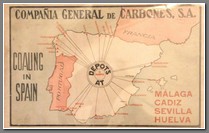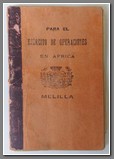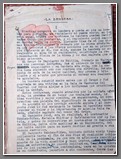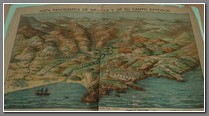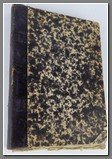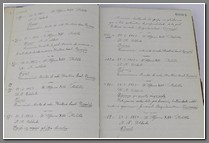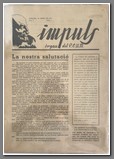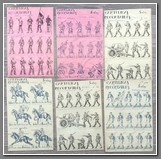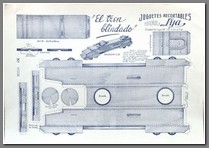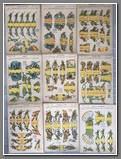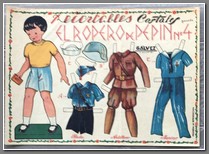Spanish Civil War /History
Military panoramic view of Melilla, early 20th century. L. Ciriza del. Lit. E. Fernandez. Feijoo 3. Madrid. 44x32cm. At the bottom is the description of the view, the Horcas camp, Venadito ship, Monte gurugú, Neutral Zone, etc. Repaired with acid-free tape, damaged edges not affecting the map proper.
Price: $250.00
Melilla, Guerra del Rif, Book off surgical operations of a military doctor, is a diary of a military doctor, where he recorded all the surgical operations he carried out, since january 3, 1923 at the Alfonso XIII hospital in Melilla(Rif War), until december 20, 1928 at the military hospital in Madrid. War wounds are reported, name of the wounded, result of surgery(cured, deceased). 392 pages, with a total 1264 interventions. Measures 22x16,5 cms. Very Rare.
Price: $1500.00
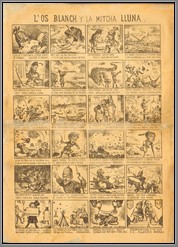 SCW 545Very early Catalan auca telling the story of the 1877-1878 Balkan War. Appears to be critical of Russia. Very rare. Professionally restored. B
SCW 545Very early Catalan auca telling the story of the 1877-1878 Balkan War. Appears to be critical of Russia. Very rare. Professionally restored. B
Price: $800.00
Note: An auca is a graphic format popular in Spain and especially in the region of Catalonia around Barcelona. The genre dates at least to the 17th century but was banned during the 18th century before experiencing a renewal during the 19th and later the 20th centuries as a uniquely Catalonian form of expression. It takes the form of a cartoon or a comic strip, typically with 48 blocks of image and text, although some may have less. An auca is generally produced as a single sheet, but occasionally a booklet form is used. The captions tend to have some sort of consistent rhyme to assist with the flow and storytelling. Many times the term “auca” appears in the title, but another term, “aleluya,” is used, apparently interchangeably. Some sources indicate that the aleluya originated in Castile and originally included religious elements that were shed over time. Auca was a very popular form of anti-Nationalist propaganda during the Civil War.
DESPERTAR. Boletin interno de la Confederacion Nacional del Trabajo de España en el exilio. Cultura e información social. No destinado a la venta pública. (WAKE UP. Internal bulletin of the CNT of Spain in exile. Culture and social information. Not intended for public sale). Printed by Société Gnénérale d'Impression. Toulouse, 1961. Size: 57x45,5 cm. 7 numbers: #1, 12th november to #7, 24th december. 4 pages each one. Visible folds. Editorial secretary: Federica Montseny. Managing director: A. Turmo. Administrator: M. Celma. Complete collection. Published after the CNT was banned, its publication ceased at the end of 1961 for the same reason. B
Price: $2000.00
1937-1938 childrens coloring book by fascist artist Laokin. In 6 frames it glorifies the Nationalist cause, with marching off to war and supported by the people, the support from other fascist nations, triumph over animal-like communists, glorification of the Nationalist cause, Republicans cowtowing to the Nationists and Monarchists. Rare M ah kh
Price: $800.00
 SCW 551 SCW 551 |  SCW 551 SCW 551 |  SCW 551 SCW 551 |  SCW 551 SCW 551 |
 SCW 544Three page manuscript produced by Captain Benedettini Luigi Filippo, with the Italian airforce fighting in Spain. It provides tactical intelligence on the communists on the Ebro front on July 25, 1938. It reads:
SCW 544Three page manuscript produced by Captain Benedettini Luigi Filippo, with the Italian airforce fighting in Spain. It provides tactical intelligence on the communists on the Ebro front on July 25, 1938. It reads:
Reminder per S.E.
The defensive actions of the reds had a surprise characteristic only where the reconnaissance aviation was unable to evolve its activity.
The passage of the Ebro by the reds on 25 July 1938 was carried out while the only reconnaissance squadron had been transferred from the Campo de la Salada (Alcaniz) to the field of Teruel to cooperate in the action on Valencia in which the Italian troops participated. Nonetheless, since June 25, before the transfer to Teruel, the observers of the I20 Squadriglia O.A. they had reported unusual movements on the left bank of the Ebro, setting aside bridge materials on the same bank, they had seen boats hidden near the opposing bank, they had noticed the launch of walkways from the left bank to some islet of the Ebro on which it was transported of the material. These news also result from the reports presented and from the extensive photographic documentation that was carried out in the daily reconnaissance of the Ebro. The same bulletin from the Information Office of the C.T.V. reports the news that saw the intention of the action of the reds.
The red troops were then able to make the passage on 25 July because, once the surveillance of the reconnaissance on the area ceased, they found only a veil of national troops who could not prevent their rapid advance up to one km. from Gandesa.
In this circumstance a section of the O.A. Squadron was immediately detached from Teruel to Caspe with two observer officers for the needs of the reconnaissance service over that area.
On 2 August the whole squadron was again transferred from the Teruel front to that of the Ebro, where I participated intensely in the reconquest of the territory occupied by the reds.
In the action attempted again by the reds on September 9 on the Teruel-Garrion front in which the summit of Creventada was occupied, he was surprised because that front lacked the reconnaissance used on the Ebro sector. To paralyze the action, a bombing formation was sent which, however, was unable to complete the mission promptly due to bad weather conditions that prevented it from seeing the land to be bombed.
Reconnaissance aviation is effectively used in observation, sight, topographical surveying and action tasks on Valencia, in the service of artillery, where it has established itself as extremely useful in the search for enemy batteries (hidden and masterfully masked by the reds) and in the shooting observations. The artillery service was carried out continuously from the early hours of the day until sunset, with the change on the spot after an hour and a half of stay of each plane.
The service rendered with the topographic surveys of the opposing area is very important, which allowed a special observer officer specialized in photographic interpretations and assigned to the Headquarters Command, to obtain all the elements (entrenchments in the woods, works of fortifications, batteries, ammunition depots, encampments) which were effectively beaten by both artillery and air force.
This contribution of the reconnaissance aviation and the delicate work of photographic interpretation have received from Generalissimo Franco and General Kindeland (National Aviation Committee) the highest recognition for the truly invaluable value that it has also in this very important field was able to reach the Italian Air Force.
For this purpose, at the behest of the Generalissimo, a course in photographic interpretation was carried out by Spanish aviators, which was entrusted to the Italian observer officer chosen for the headquarters.
This Officer was also entrusted by the Spanish Command with the task of cooperating in the preparation of topographic maps of the enemy areas, through the exploitation of metric aerial plane works and for this purpose he was sent to Italy to provide photogrammetric materials for expeditious surveys.
Capitano Benedettini Luigi Filippo. M
Price: $100.00


